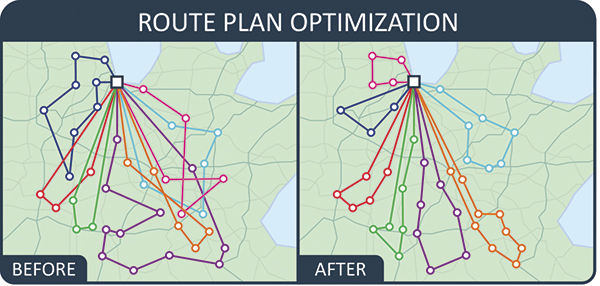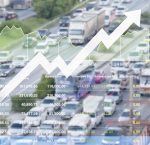Route optimization software makes sound business sense for any organization responsible for sending fleets of 18-wheelers all over the country. But fleets of smaller work trucks can benefit from routing software just as much.
At heart, route optimization is a solution to the daunting challenge of figuring out the quickest and most efficient way of sending multiple vehicles to multiple customer sites while hitting tight time windows. Even with a dozen vehicles, the number of possible route configurations becomes impossible for a human brain to manage efficiently and economically. The computer algorithms in route optimization software are specifically designed to incorporate the myriad constraints that face a typical transportation operation every day. They create feasible and cost-effective routes within minutes compared to the hours it takes to do so manually.
Wherever there’s complexity in planning and executing physical visits to customer sites for delivery, sales, or services—whether via light-, medium-, or heavy-duty trucks—there are huge operational efficiency gains to be made by deploying route optimization software.
The benefits can be dramatic. Companies that switch from manual or unsophisticated route planning to advanced route optimization software can reduce transportation costs by 10 to 30% in a matter of months. Whether your annual fleet operating costs are in the thousands or millions, that’s most likely a sizeable chunk of your profit margin. Let’s look at the various ways that automating truck route planning could drive value for your business.
SAVE MONEY
Every unnecessary mile you drive is costing you money through labor, vehicle costs, maintenance, and fuel. Fleet operating costs plummet when you complete routes in less time using fewer miles.
For example, Michigan-based cleaning services company Hagopian, a family-owned firm providing cleaning and restoration of carpets and upholstery, visits 40,000 homes per year with its fleet of 27 vans. After implementing route optimization software, the company reduced its annual fleet miles by 10%, cutting fuel costs by more than $7,500 per year, and saving a total of $250,000 in salary and benefits—all while standardizing procedures across the company, thereby improving customer service.
The AKI Group, a retail and health care distributor based in the United Arab Emirates, has been able to reduce the size of its fleet from 84 to 52 commercial vehicles as a result of implementing routing software, while average deliveries per vehicle have increased from 4.7 to 12.4, a rise of 164%. And the company saved $1 million per year in transportation costs, to boot.
ON-TIME DELIVERIES
By factoring in all the variables that can impact delivery time—things like vehicle restrictions, rush-hour traffic, and historical unload times per location along the route—routing software helps you hit very precise ETA windows.
Toronto-based catering company, Marigolds & Onions, uses 10 vans to deliver 110 large catering orders a day—all requiring delivery within a 15-minute window. If an order is late, even by 5 minutes, it’s considered a failed delivery. Through adoption of automated route planning tools, the company greatly increased the accuracy of the transport plan to ensure the correct driving time was allocated for each route through the dense urban area where the majority of its clients are located. As a result, they now consistently hit those very tight time windows.
INFORMED DECISIONS
Route optimization software is both a day-to-day operational tool and a strategic planning tool that allows you to model, using your own data, the cost and service impacts of major strategic changes. For instance, what if you changed the location of your vehicle terminal or added a new one? Or what if you expanded your service territory—could you still make money?
LF&E Refrigerated Transport, a provider of temperature-controlled logistics services, used routing software to determine where to locate a new warehouse. After modeling results from several sites, LF&E identified a location that cut 800 miles a day off its delivery routes, reducing the cost per delivery and increasing the volume of orders handled by its existing fleet.
REDUCE CARBON EMISSIONS
More efficient routes mean fewer miles and less fuel. When your fleet is burning less fuel, you’re reducing your carbon footprint. It’s as simple as that.
News UK, which publishes The Times newspaper, reduced its home delivery routes by 16% using advanced routing and scheduling software. The software helps the planning team to cluster deliveries and shorten routes, meaning they need fewer vehicles, burning less fuel, consequently reducing both costs and the carbon footprint of the operation.

Routing software optimizes routes to minimize time and miles driven, reducing fleet costs by 10 to 30%.
IMPROVE ROUTES
Route optimization software allows for a continuous improvement loop, where information gathered from drivers, customer service, dispatch, and telematics systems can be fed back into the software to make tomorrow’s route plans even more efficient than today’s. It really is the gift that keeps on giving.
WASTING MONEY?
Work truck fleets are ideal candidates for the benefits of routing software with multiple trucks deployed across a region for multi-stop routes. Still, many fleet operators choose to manage this complexity using manual or semi-automated processes.
Maybe you’ve never heard of route optimization software before, or you’ve thought about it and rejected the idea. Or the size of your managed fleet makes you comfortable that one or two workers can take care of planning and dispatching vehicles and drivers without sophisticated algorithms. Or perhaps your transportation routes are comfortably predictable—same routes, same days, same orders or tasks, same customers.
This is tunnel vision. If you’re not taking advantage of the benefits of routing software, the chances are you’re throwing money out the window. You’re probably giving your customers sub-par service, too.
ABOUT THE AUTHOR
William Salter is the CEO of Paragon Software Systems. Paragon has provided advanced routing and scheduling software for more than 30 years, cutting transportation costs and improving efficiency across a wide range of distribution operation types and industry sectors. Paragon has more than 4,700 systems in place at over 1,400 client sites in 61 countries. Find out more, visit www.paragonrouting.com.
_______________________________________________
MODERN WORKTRUCK SOLUTIONS:
JANUARY 2020 ISSUE
Did you enjoy this article?
Subscribe to the FREE Digital Edition of Modern WorkTruck Solutions magazine.




